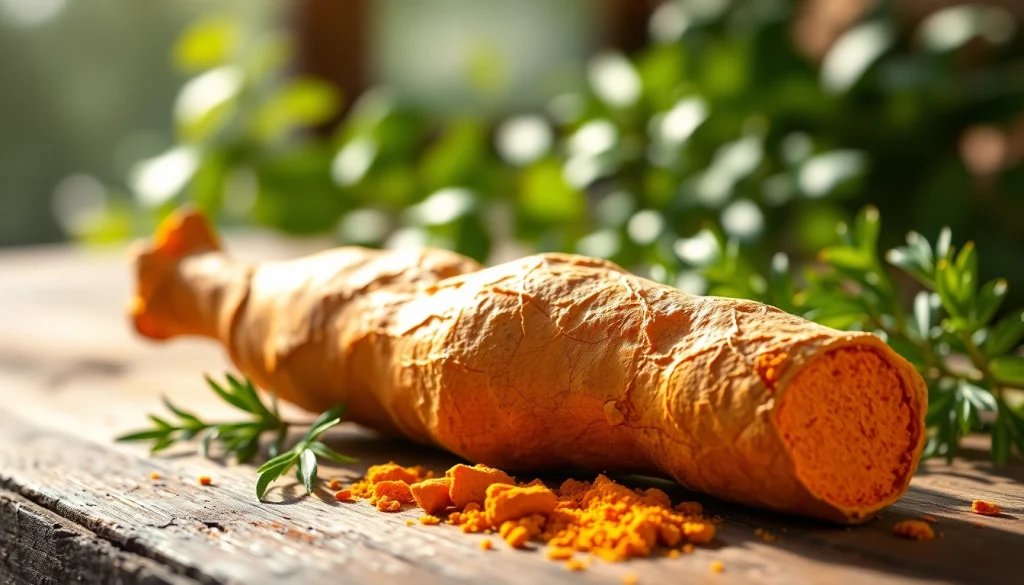Health Benefits and Uses of Turmeric Root in Daily Life

Introduction to Turmeric Root
Turmeric root, scientifically known as Curcuma longa, is a vibrant yellow-orange rhizome, closely related to ginger. It has a rich history intertwined with culinary and medicinal practices across various cultures, particularly in Asia. Beyond its bright color, turmeric is celebrated for its extensive health benefits and versatile applications in cooking. Historically, it has been used for centuries in Ayurvedic and traditional Chinese medicine, where it is revered for its anti-inflammatory and antioxidant properties. Today, a great many people seek to incorporate turmeric root into their diets, drawn by its potential health advantages and vibrant flavor.
What is Turmeric Root?
Turmeric root is the underground stem (rhizome) of the Curcuma longa plant, native to tropical South Asia. Beyond its culinary use, turmeric is a powerhouse of nutrients, primarily due to a compound known as curcumin, which imparts many of its health benefits. The root can be used fresh, dried, or powdered, providing a warm, slightly bitter flavor that enhances a variety of dishes. The vibrant yellow hue of turmeric comes from the bioactive compounds in curcumin, making it a popular natural dye in addition to its culinary applications.
The Origins and History of Turmeric
Turmeric has a long and storied history, dating back over 4,000 years. Originating in the Indian subcontinent, it was initially used for its flavor and color in cooking. It soon became central to traditional medicine systems like Ayurveda and Siddha, believed to cure a wide array of ailments, including respiratory issues, digestive disorders, and skin conditions. Moreover, turmeric’s religious significance cannot be overlooked, being a key ingredient in various Hindu rituals and celebrations. Asian traders played a crucial role in disseminating turmeric beyond the Indian subcontinent, paving the way for its adoption in cuisines and medicinal practices worldwide, including China, the Middle East, and parts of Africa.
How Turmeric Root is Cultivated
Turmeric is cultivated primarily in Asia, especially in countries such as India, which produces around 80% of the world’s supply. The plant thrives in warm, humid climates with well-drained soils. Farmers typically plant the rhizomes in fields during the pre-monsoon season; they require a lengthy vegetation cycle of around 7 to 10 months before the rhizomes are ready for harvest. Once harvested, the turmeric roots are washed, boiled, and dried in the sun, which preserves their potency while enhancing their flavor profile. This labor-intensive process distinguishes high-quality turmeric from lower-grade alternatives, making fresh, organic turmeric root particularly sought after.
Health Benefits of Turmeric Root
One of the best-documented aspects of turmeric root is its health benefits. Much of the research focuses on curcumin, the yellow pigment that comprises around 3% of turmeric. Numerous studies have highlighted turmeric’s potential in preventing and managing various health conditions.
Anti-inflammatory Properties of Turmeric Root
Chronic inflammation is a contributing factor to numerous health conditions, ranging from arthritis to heart disease. Curcumin, the active component in turmeric, possesses potent anti-inflammatory properties. Studies indicate that curcumin can inhibit inflammatory molecules in the body, making it a natural alternative to conventional anti-inflammatory medications. For instance, a meta-analysis published in the journal Phytotherapy Research concluded that curcumin significantly reduces markers of inflammation, leading to better management of conditions like rheumatoid arthritis and inflammatory bowel diseases.
Turmeric Root and Digestive Health
Turmeric is well-regarded for promoting digestive health. It stimulates bile production, aiding in fat digestion and nutrient absorption. Moreover, turmeric has been traditionally used to alleviate symptoms of indigestion and bloating. The anti-inflammatory properties of curcumin can also soothe gastrointestinal inflammation, which may be beneficial for those suffering from conditions like ulcerative colitis and irritable bowel syndrome (IBS). Research published in the journal Journal of Clinical Gastroenterology reported that participants who consumed turmeric experienced significant relief from digestive discomfort compared to those who did not.
Turmeric Root’s Antioxidant Benefits
Free radicals are harmful molecules that can cause oxidative stress, leading to cellular damage and contributing to chronic diseases, aging, and inflammation. Curcumin acts as a powerful antioxidant, neutralizing free radicals and boosting the body’s overall antioxidant capacity. Various studies have shown that consistent consumption of turmeric root can enhance the body’s defense mechanisms, offering protection against oxidative stress-related diseases including cancer and heart disease. Research in the journal Cancer Letters suggests that curcumin’s antioxidant properties may help in the prevention of cancer cell proliferation.
Incorporating Turmeric Root into Your Diet
Adding turmeric root to your diet can enhance your meals while providing notable health benefits. Here, we explore various methods to incorporate this beneficial spice into your daily routine.
Raw Uses: Cooking with Fresh Turmeric Root
Fresh turmeric root can be used much like ginger in various dishes. Its unique flavor pairs well with different ingredients, enhancing both taste and health benefits. You can add grated turmeric root to stir-fries, soups, and salads, or use it to create vibrant marinades for vegetables and proteins. Freshly juiced turmeric root can be a zesty addition to drinks or smoothies, providing both flavor and health benefits at the same time.
How to Prepare Turmeric Root for Smoothies and Drinks
To incorporate turmeric root into your smoothies, peel about a 1-inch piece of fresh turmeric, slice it into smaller pieces, and blend it with your favorite fruits and vegetables. For added benefits, pair turmeric with a pinch of black pepper; this enhances curcumin absorption in the body. You can also brew turmeric root with ginger and lemon to create a detoxifying herbal tea, making for a refreshing and health-promoting beverage.
Recipes Featuring Turmeric Root
Here are a few quick recipe ideas to incorporate turmeric root into your meals:
- Turmeric Ginger Tea: Boil 2 cups of water, add a thumb-sized piece of fresh turmeric (sliced) and ginger, simmer for 10-15 minutes, strain, and enjoy.
- Turmeric Roasted Vegetables: Toss your favorite vegetables with olive oil, minced garlic, grated turmeric root, and season with salt and pepper. Roast until tender.
- Golden Milk: In a saucepan, mix coconut or almond milk with grated turmeric, a pinch of black pepper, and honey or maple syrup for sweetness. Heat gently, whisking to combine.
Potential Side Effects and Precautions
While turmeric root is generally safe for most people, some may experience side effects or interactions with medications. It is crucial to understand these considerations before incorporating it into your diet.
Possible Side Effects of Turmeric Root Consumption
Some individuals might experience gastrointestinal discomfort, such as upset stomach or mild diarrhea, particularly when consuming large amounts of turmeric. It’s advisable for those with gallbladder issues to avoid excess turmeric, as it can increase bile production. Additionally, caution is warranted for pregnant or breastfeeding women, as extensive studies on the effects are limited.
Who Should Avoid Turmeric Root?
Individuals on blood-thinning medication or those who suffer from clotting disorders should consult with a healthcare professional before using turmeric in therapeutic amounts, as it can enhance blood thinning and lead to increased bleeding risk. People scheduled for surgery should also discontinue high doses of turmeric two weeks prior to their procedure to minimize complications.
How to Properly Store Turmeric Root
For optimal freshness, store turmeric root in a cool, dark place such as a pantry or a refrigerator. Fresh turmeric can last several weeks when kept unpeeled in the fridge. For long-term storage, consider freezing it after peeling and slicing, which maintains its flavor and health benefits while preventing spoilage.
Conclusion: The Value of Turmeric Root
In summary, turmeric root offers a myriad of health benefits, making it a valuable addition to the modern diet. From its anti-inflammatory and antioxidant properties to its versatility in dishes, turmeric root stands out as a superfood. As with any supplement or dietary change, it’s wise to consult with a healthcare provider to ensure it aligns with your individual health needs.
Recap of Turmeric Root Benefits
To recapture the essence of turmeric root, it improves digestive health, exhibits potent anti-inflammatory properties, and is a robust antioxidant source. These qualities contribute to its growing popularity as a natural remedy for various health issues.
Final Thoughts on Adding Turmeric Root to Your Diet
Incorporating turmeric root into your meals can be a delicious and health-promoting choice. With many unique and creative ways to use it, this ancient spice continues to condense thousands of years of traditional wisdom into manageable bites of beneficial goodness in our modern lives.
Resources for Further Reading on Turmeric Root
If you are interested in learning more about turmeric root, consider reading the following:
- Turmeric Benefits | Johns Hopkins Medicine
- Turmeric Benefits: A Look at the Evidence | Harvard Health
- 10 Health Benefits of Turmeric and Curcumin | Healthline
- Turmeric – Uses, Side Effects, and More | WebMD






